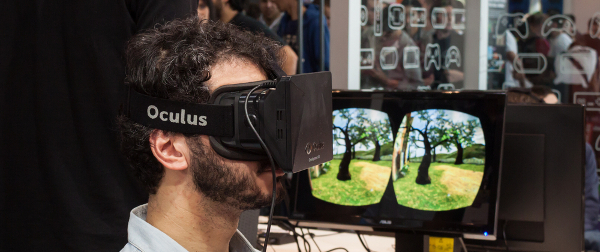
In the week Facebook splashed out $2bn for Oculus VR, the California-based virtual reality (VR) company that makes headsets for gamers, Luxottica, the Italian maker of Ray-Ban sunglasses, also struck a deal to design, develop and distribute Google’s eyewear for Google Glass.
So what’s the difference between Google Glass and Oculus Rift?
1. Technology
Designed almost exclusively for gamers, the Oculus goggles immerse the wearer into a 3D VR fantasy that allows them to navigate games and other experiences with just the movement of their heads.
The ski-like-goggles, codenamed Crystal Cove, have sensors and a camera designed to track the position of both your head and body, and provide a more accurate simulated movement.
On the other hand, the concept of Google Glass is more like a smartphone with augmented reality possibilities, but everything is delivered directly to the eyes. For example, it can record video, access email, and retrieve information from the web by connecting wirelessly to a user’s mobile phone.
2. Design
The latest version of Oculus’s 3D headset has a 960x 1,080 OLED display, which Oculus says is larger than a smartphone but smaller than a tablet, while Glass’s display has a 640X360 pixel resolution, which Google claims provides the equivalent to that of a 25-inch HD display when viewed from eight feet away.
The goggles come with optical tracking tools, allowing users to lean in and out, and look at objects from multiple angles. According to Oculus, the design tries to cut down on motion blur and nausea induced side effects, while other features include a USB port, invisible IR LEDs and a power button.
Other Google Glass tech specs, which Google revealed in April 2013, include a bone conduction transducer that provides audio, a 5-megapixel camera with 720p video capture and 16GB of flash memory.
Glass also supports Wi-Fi and Bluetooth connectivity, and has a ‘Listen’ and ‘Capture’ button, a touch-sensitive area, and a USB port for charging.
3. Applications
"We’re going to make Oculus a platform for many other experiences," said Facebook founder and CEO Mark Zuckerberg, announcing the deal on March 25.
"Imagine enjoying a courtside seat at a game, studying in a classroom of students and teachers all over the world or consulting with a doctor face-to-face – just by putting on goggles in your home."
According to online site Live Science, the VR goggles are also being explored for PTSD therapy, helping people who have lost an arm or leg, to controlling robots avatars and soldiers.
In comparison, real-life examples of Google Glass expected to go into action range from sentiment analysis that detects human feelings based on facial expressions, fitness reality games and an app to help fire fighters to work faster and safer.
Check out CBR’s five real-life examples of Google Glass in action for more details.
4. Price
Oculus currently charges $300 for a low resolution pair for companies interested in developing software for the device, and has shipped more than 75,000 worldwide, which are scheduled to be delivered in July.
The price of Google Glass is currently $1,500, which doesn’t include tax or the frames for prescription lenses and sunglasses you might need to go with it. However the retail price, which is expected to be announced later this year, could be a lot cheaper, possibly costing as much as a high end smart phone.
Check out CBR’s article explaining the cost of Google Glass to find out why.






